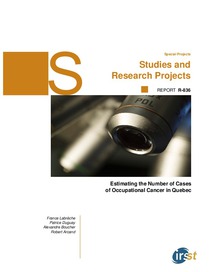Estimated number of cases of occupational cancer in Quebec
"As in most industrialized societies, cancer is the leading cause of death in Quebec: in 2013, it is estimated that 20,200 people will die of cancer and that 48,700 new cases will be diagnosed. Carcinogenesis is a complex, multifactorial process that begins many years before clinical symptoms o...
| Main Authors: | , , , |
|---|---|
| Institution: | ETUI-European Trade Union Institute |
| Format: | TEXT |
| Language: | English |
| Published: |
Montréal
2013
IRSST |
| Subjects: | |
| Online Access: | https://www.labourline.org/KENTIKA-19399309124911175819-estimated-number-of-cases-of-o.htm |
| Summary: | "As in most industrialized societies, cancer is the leading cause of death in Quebec: in 2013, it is estimated that 20,200 people will die of cancer and that 48,700 new cases will be diagnosed. Carcinogenesis is a complex, multifactorial process that begins many years before clinical symptoms of cancer appear. Cancer is considered to be occupational in origin when it results from workplace exposure to a chemical, physical or biological agent, or from conditions inherent in a work activity. The disease would probably not have developed if the person had not done that job. A number of studies have estimated that from 2% to 8% of all cases of cancer are attributable to work, depending on the country and the number of cancer sites and types considered. However, for some sites or types, the proportion of cases attributable to work is far higher: occupation is thought to account, for instance, for over 90% of all cases of pleural mesothelioma in men. To be able to prioritize research and prevention needs, an accurate picture of the extent of the problem is needed. The purpose of this report is therefore to present an estimate of the number of cases of occupational cancer among Quebec workers.
The number of cases of workplace cancer was estimated by means of two complementary methods: first, using Quebec workers’ compensation data for cases of occupational cancer and, second, based on the published percentages for forms of cancer attributable to work. While these two data sources have certain limitations, they offer the advantage of being readily available and allowing forms of cancer to be classified for the purposes of setting research priorities and guiding prevention initiatives.
According to cancer compensation data from the Commission de la santé et de la sécurité du travail (workers’ compensation board, or CSST), in Quebec, fewer than 100 workers were compensated annually between 2005 and 2007 for a new diagnosis of work-related cancer. In 362 of the files opened between 1997 and 2005, compensation was paid out to people who died of cancer, including six women (all from mesothelioma). For men, over half of cases were mesothelioma, of the pleura or the peritoneum, with the second leading cause being lung cancer. The majority of workers compensated had been employed in manufacturing, mining or construction. Owing in part to the difficulty of establishing a cause-and-effect relationship and also to the lengthy latency period between workplace exposure and development of the disease, compensation is paid out by the CSST in only a small number of cancer cases. ..." |
|---|---|
| Physical Description: | 47 p. Digital |

